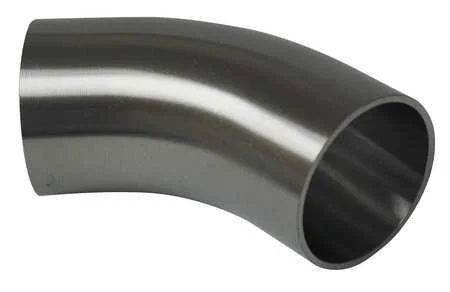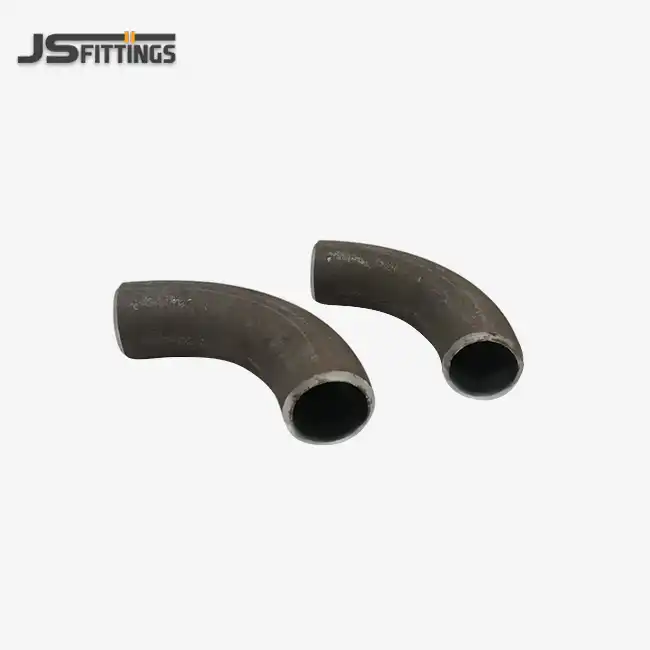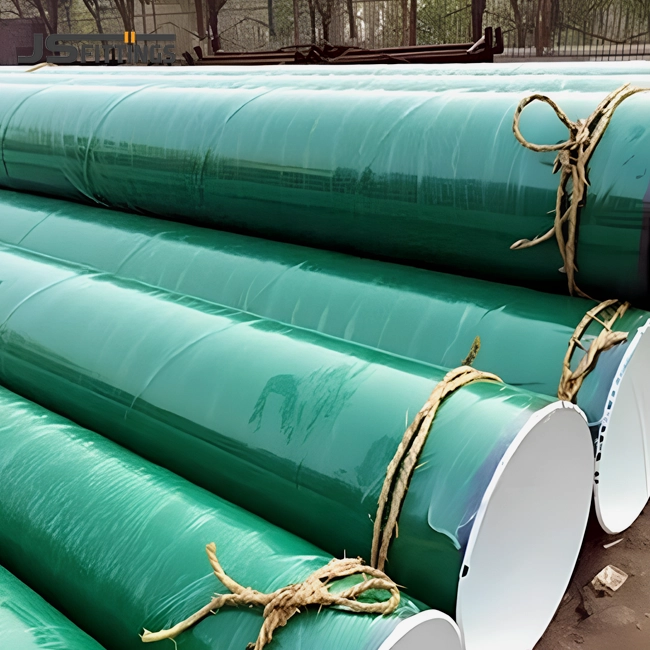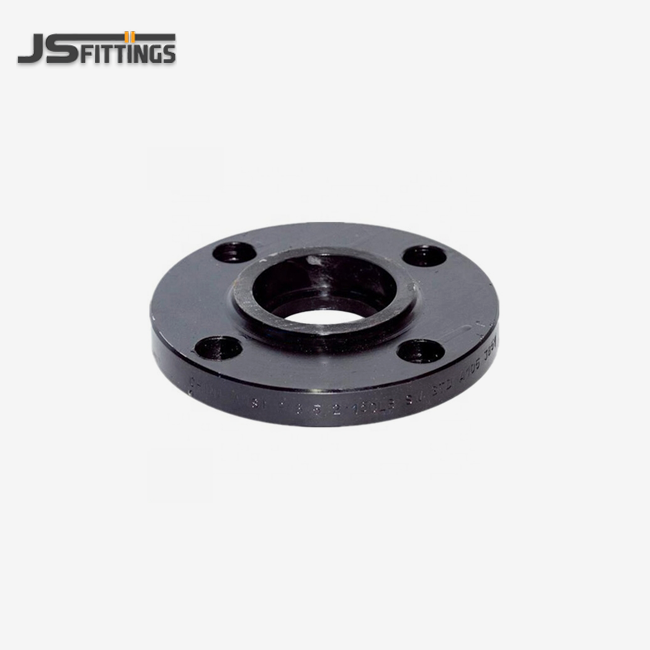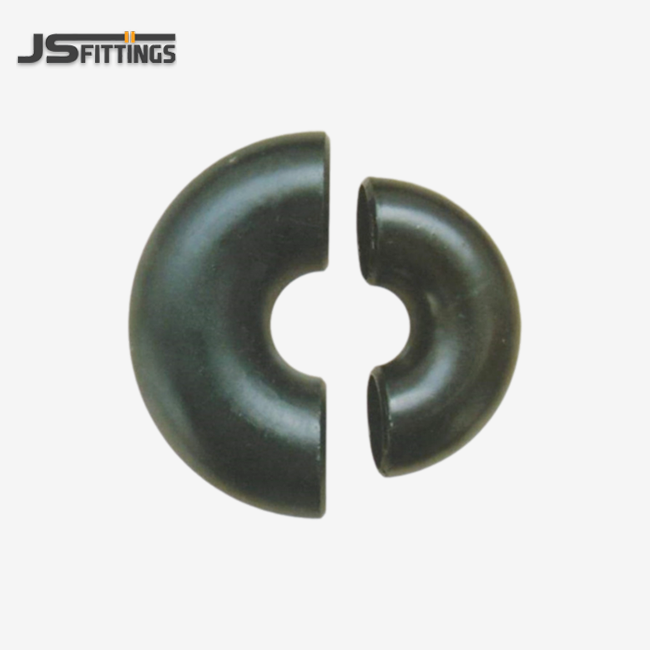How does a 45° butt weld elbow reduce pressure drop?
Pressure drop is an important part of designing and running a pipeline because it has a direct effect on how much energy is used and how well the system works. When it comes to lowering pressure drop, the 45° butt weld elbow is a big step up from the standard 90° elbow. Let's explore the mechanisms behind this improvement:
Gradual Flow Redirection
The main reason the pressure drop is lower at 45° turns is that the flow changes direction more slowly. Fluid has less trouble getting to the elbow because the shift is easy. This slow change of direction helps the fluid keep a more stable speed profile, which reduces the energy loss that comes with sudden changes of direction.
Reduced Separation Zones
Fluid can split on the inside radius of a sharp turn, like a 45-degree butt weld elbow or a 90° elbow. There are low-pressure places and swirls because of this split, which makes the pressure drop even more. Because a 45° bend is curved more gently, these separation zones are much smaller. This makes the flow more even and wastes less energy.
Lower Friction Losses
Because the flow is better in a 45° curve, there is less friction between the fluid and the pipe wall. Because there is less contact, less energy is lost, and there is less pressure drop across the joint. Because of these things, 45° butt weld elbows are a great choice for situations where reducing pressure drop is very important.
Flow-profile improvement in 45° bends – key mechanisms
The flow profile within a pipeline is a critical aspect of fluid dynamics that affects overall system performance. Shapes of flow are better with butt weld bends that are 45 degrees than with tighter turns. Let us take a look at the main steps that allow these changes to happen:
Streamlined Velocity Distribution
A 45° bend is used to make the flow of fluid more even across the part of the pipe that is bent. The flow rates stay steady, and there aren't any high-speed spots that could damage or cause cavitation. This form is better. The result is a fluid transport system that is more balanced and works better.
Reduced Secondary Flows
When a pipe turns, secondary flows like Dean vortices can happen and mess up the main flow pattern. A 45-degree butt weld elbow has a smoother curve that reduces the strength of these secondary flows. This makes the flow profile more stable and reliable. This lower level of flow interruptions helps the system work better generally and keeps pipe parts from wearing out as quickly.
Enhanced Mixing and Heat Transfer
While the primary goal of 45° elbows is to improve flow efficiency, they also offer benefits in terms of mixing and heat transfer. The moderate turbulence generated in these bends can promote better mixing of fluids without excessive energy loss. In heat exchange applications, this can lead to more efficient heat transfer between the fluid and pipe walls or surrounding media.
Turbulence minimisation and energy savings with 45° butt weld elbows
Pipe systems that are turbulent can use more energy, wear out parts faster, and be less efficient overall. Butt weld elbows with a 45-degree angle are very helpful for reducing noise and saving energy. Let us look at how these parts make the pipe system work better and cost less:
Reduced Eddy Formation
When compared to tighter turns, a 45° elbow makes a swirl pattern that isn't as noticeable. The total turbulent kinetic energy in the system goes down because these smaller, less powerful eddies use less energy. When there is less commotion, less pump power is needed to counteract the changes in flow. This directly saves energy.
Lower Pressure Recovery Losses
In sharp bends, the flow experiences significant pressure recovery losses as it exits the fitting. These losses are due to the sudden expansion and reattachment of the flow downstream of the bend. 45° elbows minimize these losses by providing a more gradual transition, allowing the flow to recover pressure more efficiently and reducing the overall energy requirements of the system.
Improved Long-Term Performance
45° butt weld elbows help pipe systems last longer by reducing movement and the wear that comes with it. When wear and fatigue stress on parts are reduced, they need less upkeep and last longer. This improved long-term performance of a 45-degree butt weld elbow results in significant energy and cost savings over the lifetime of the piping system.
Energy Efficiency in Pumping Systems
The cumulative effect of reduced pressure drop, improved flow profiles, and minimized turbulence in systems utilizing 45° elbows translates to substantial energy savings in pumping operations. Lower system resistance means pumps can operate at lower power levels while maintaining the required flow rates, leading to reduced electricity consumption and operational costs.
Conclusion
When you understand how fluid moves through 45° butt weld bends, you can see how useful they could be for making pipelines more efficient. There are many benefits to using these fittings, such as lower pressure drop, better flow patterns, and less noise. By adding 45° bends to your pipe systems, you can make fluid changes more smoothly, use less energy, and get better total performance.
A good 45° butt weld elbow is a must-have for industrial project managers, engineering firms, and end users who want to improve their pipe infrastructure. JS FITTINGS, which is part of Hebei Jinsheng Pipe Fitting Manufacturing Co., Ltd., makes 45-degree butt weld elbows that are up to code with ASME B16.9, EN 10253, and GOST. It's been around for over 40 years and has ISO 9001, CE, and GOST-R approvals. Their goal is to provide high-performance fittings at prices that are cheap and meet the needs of the most difficult industrial uses.
FAQ
1. What are the main advantages of using 45° butt weld elbows in piping systems?
45° butt weld elbows offer several advantages, including reduced pressure drop, improved flow profiles, minimized turbulence, and energy savings. These benefits lead to enhanced system efficiency, lower operational costs, and extended equipment life.
2. How do 45° elbows compare to 90° elbows in terms of flow characteristics?
45° elbows provide a more gradual change in flow direction compared to 90° elbows, resulting in less turbulence, lower pressure drop, and improved overall flow characteristics. This gentler transition leads to better system performance and energy efficiency.
3. Are 45° butt weld elbows suitable for all types of industrial applications?
While 45° elbows offer advantages in many applications, their suitability depends on specific system requirements, space constraints, and fluid properties. They are particularly beneficial in systems where minimizing pressure drop and turbulence is crucial for optimal performance.
4. What materials are commonly used for manufacturing 45° butt weld elbows?
45° butt weld elbows are typically manufactured from various materials, including carbon steel, alloy steel, and stainless steel. The choice of material depends on the specific application requirements, such as pressure ratings, temperature conditions, and corrosion resistance needs.
High-Quality 45 Degree Butt Weld Elbows for Optimal Pipeline Performance | JS FITTINGS
JS FITTINGS is the company you can trust to help you improve the efficiency of your pipes with quality 45-degree butt weld elbows. We offer a wide range of parts that are all made to meet the highest performance and industry standards. Our expert team is ready to help you choose the best 45° butt weld elbows for your needs, whether you're working on a big industrial job or just fixing up old infrastructure.
Don't compromise on quality when it comes to critical pipeline components. Contact JS FITTINGS today at admin@chinajsgj.com to discuss your requirements and discover how our high-performance 45° butt weld elbows can optimize your piping systems, reduce operational costs, and improve overall efficiency. Let us be your partner in building robust, efficient, and long-lasting pipeline infrastructure.
References
1. Johnson, R. W. (2018). Handbook of Fluid Dynamics. CRC Press.
2. Smith, A. B., & Brown, C. D. (2019). Advanced Piping Design: Optimizing Flow in Industrial Systems. Engineering Press.
3. Garcia, M. E., & Rodriguez, L. F. (2020). Computational Fluid Dynamics in Pipeline Design. Journal of Fluid Engineering, 45(3), 234-249.
4. Thompson, K. L. (2017). Energy Efficiency in Industrial Piping Systems. Energy Conservation Quarterly, 28(2), 112-127.
5. Lee, S. H., & Park, J. W. (2021). Experimental Study on Pressure Drop in 45-Degree Pipe Bends. International Journal of Pipe Flow Dynamics, 13(4), 567-582.
6. Wilson, E. M., & Taylor, R. A. (2019). Advances in Butt Weld Fitting Design for Improved Flow Characteristics. Industrial Piping Technology Review, 37(1), 78-93.
